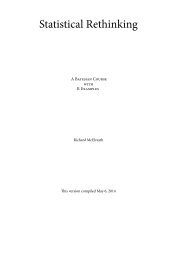the relation of habitual thought and behavior to language
the relation of habitual thought and behavior to language
the relation of habitual thought and behavior to language
You also want an ePaper? Increase the reach of your titles
YUMPU automatically turns print PDFs into web optimized ePapers that Google loves.
RELATION OF HABITUAL THOUGHT AND BEHAVIOR TO LANGUAGE<br />
(answering <strong>to</strong> our nomic present) . The<br />
aspects denote different degrees <strong>of</strong> duration<br />
<strong>and</strong> different kinds <strong>of</strong> tendency 'during<br />
duration.' As yet we have noted<br />
nothing <strong>to</strong> indicate whe<strong>the</strong>r an event is<br />
sooner or later than ano<strong>the</strong>r when both<br />
are reported . But need for this does not<br />
arise until we have two verbs, i .e. two<br />
clauses . In that case <strong>the</strong> 'modes' denote<br />
<strong>relation</strong>s between <strong>the</strong> clauses, including<br />
<strong>relation</strong>s <strong>of</strong> later <strong>to</strong> earlier <strong>and</strong> <strong>of</strong> simultaneity<br />
. Then <strong>the</strong>re are many detached<br />
words that express similar <strong>relation</strong>s, supplementing<br />
<strong>the</strong> modes <strong>and</strong> aspects . The<br />
duties <strong>of</strong> our three-tense system <strong>and</strong> its<br />
tripartite linear objectified 'time' are distributed<br />
among various verb categories,<br />
all different from our tenses ; <strong>and</strong> <strong>the</strong>re is<br />
no more basis for an objectified time in<br />
Hopi verbs than in o<strong>the</strong>r Hopi patterns ;<br />
although this does not in <strong>the</strong> least hinder<br />
<strong>the</strong> verb forms <strong>and</strong> o<strong>the</strong>r patterns from<br />
being closely adjusted <strong>to</strong> <strong>the</strong> pertinent<br />
realities <strong>of</strong> actual situations .<br />
Duration, Intensity, <strong>and</strong> Tendency<br />
in SAE <strong>and</strong> Hopi<br />
To fit discourse <strong>to</strong> manifold actual situations<br />
all <strong>language</strong>s need <strong>to</strong> express durations,<br />
intensities, <strong>and</strong> tendencies . It is<br />
characteristic <strong>of</strong> SAE <strong>and</strong> perhaps <strong>of</strong> many<br />
o<strong>the</strong>r <strong>language</strong>-types <strong>to</strong> express <strong>the</strong>m<br />
metaphorically . The metaphors are those<br />
<strong>of</strong> spatial extension, i.e . <strong>of</strong> size, number<br />
(plurality), position, shape, <strong>and</strong> motion .<br />
than objective fact, <strong>and</strong> coinciding with objective<br />
fact later than <strong>the</strong> status quo <strong>of</strong> <strong>the</strong><br />
speaker, this status quo, including all <strong>the</strong> subsummation<br />
<strong>of</strong> <strong>the</strong> past <strong>the</strong>rein, being expressed<br />
by <strong>the</strong> reportive . Our notion 'future' seems <strong>to</strong><br />
represent at once <strong>the</strong> earlier (anticipation) <strong>and</strong><br />
<strong>the</strong> later (afterwards, what will be), as Hopi<br />
shows . This paradox may hint <strong>of</strong> how elusive<br />
<strong>the</strong> mystery <strong>of</strong> real time is, <strong>and</strong> how artificially<br />
it is expressed by a linear <strong>relation</strong> <strong>of</strong> pastpresent-future<br />
.<br />
2 0 5<br />
We express duration by long, short, great,<br />
much, quick, slow, etc . ; intensity by<br />
large, great, much, heavy, light, high, low,<br />
sharp, faint, etc . ; tendency by more, increase,<br />
grow, turn, get, approach, go,<br />
come, rise, fall, s<strong>to</strong>p, smooth, even, rapid,<br />
slow, <strong>and</strong> so on through an almost inexhaustible<br />
list <strong>of</strong> metaphors that we<br />
hardly recognize as such since <strong>the</strong>y are<br />
virtually <strong>the</strong> only linguistic media available<br />
. The non-metaphorical terms in this<br />
field, like early, late, soon, lasting, intense,<br />
very, tending, are a mere h<strong>and</strong>ful, quite<br />
inadequate <strong>to</strong> <strong>the</strong> needs .<br />
It is clear how this condition 'fits in .'<br />
It is part <strong>of</strong> our whole scheme <strong>of</strong> objectifying-imaginatively<br />
spatializing qualities<br />
<strong>and</strong> potentials that are quite non-spatial<br />
(so far as any spatially-perceptive senses<br />
can tell us) . Noun-meaning (with us)<br />
proceeds from physical bodies <strong>to</strong> referents<br />
<strong>of</strong> far o<strong>the</strong>r sort . Since physical bodies<br />
<strong>and</strong> <strong>the</strong>ir outlines in perceived space are<br />
denoted by size <strong>and</strong> shape terms <strong>and</strong><br />
reckoned by cardinal numbers <strong>and</strong> plurals,<br />
<strong>the</strong>se patterns <strong>of</strong> denotation <strong>and</strong> reckoning<br />
extend <strong>to</strong> <strong>the</strong> symbols <strong>of</strong> non-spatial<br />
meanings, <strong>and</strong> so suggest an imaginary<br />
space. Physical shapes move, s<strong>to</strong>p, rise,<br />
sink, approach, etc ., in perceived space ;<br />
why not <strong>the</strong>se o<strong>the</strong>r referents in <strong>the</strong>ir<br />
imaginary space? This has gone so far that<br />
we can hardly refer <strong>to</strong> <strong>the</strong> simplest nonspatial<br />
situation without constant resort <strong>to</strong><br />
physical metaphors . I 'grasp' <strong>the</strong> 'thread'<br />
<strong>of</strong> ano<strong>the</strong>r's arguments, but if its 'level' is<br />
'over my head' my attention may 'w<strong>and</strong>er'<br />
<strong>and</strong> 'lose <strong>to</strong>uch' with <strong>the</strong> 'drift' <strong>of</strong> it, so<br />
that when he 'comes' <strong>to</strong> his 'point' we<br />
differ 'widely,' our 'views' being indeed so<br />
'far apart' that <strong>the</strong> 'things' he says 'appear'<br />
'much' <strong>to</strong>o arbitrary, or even 'a lot'<br />
<strong>of</strong> nonsense!<br />
The absence <strong>of</strong> such metaphor from<br />
Hopi speech is striking . Use <strong>of</strong> space<br />
terms when <strong>the</strong>re is no space involved is











